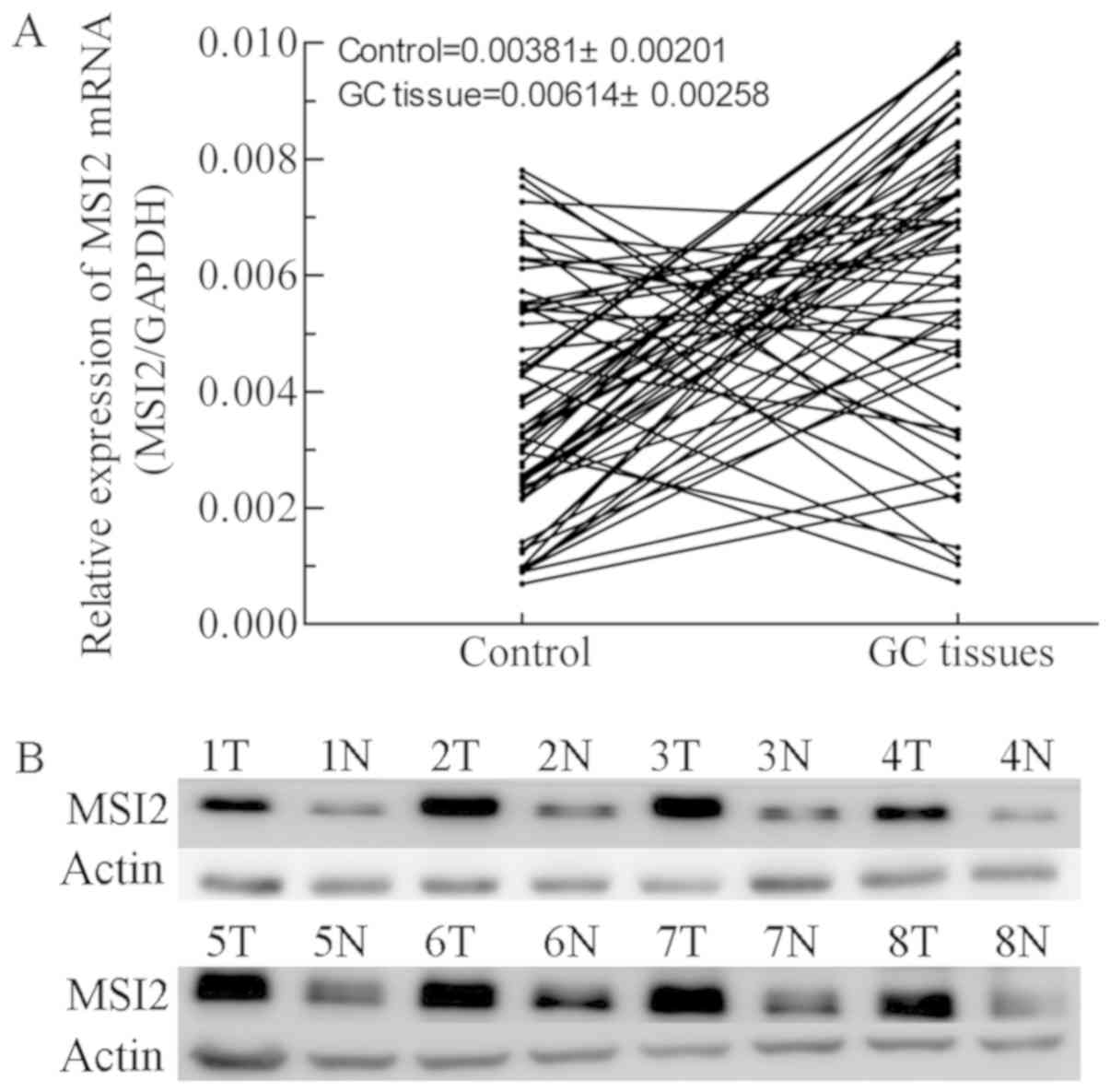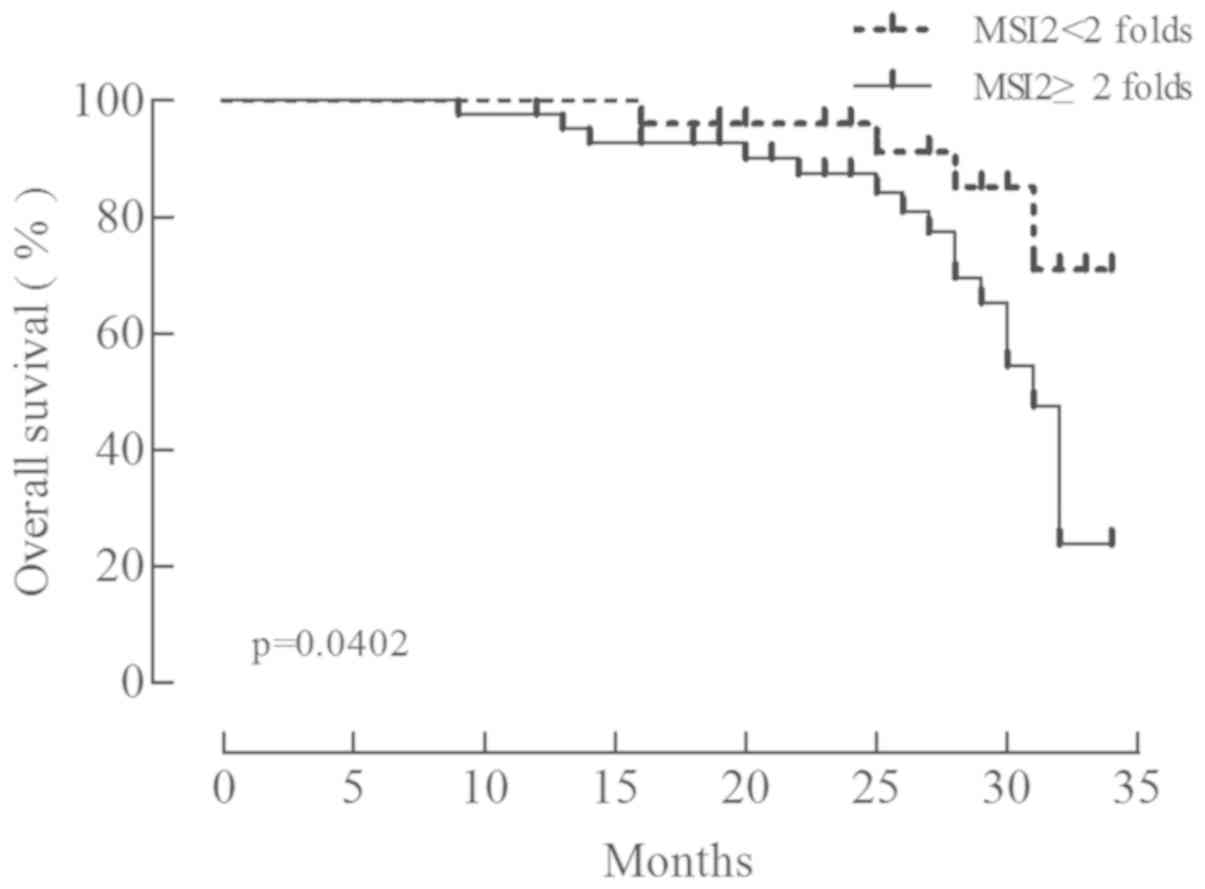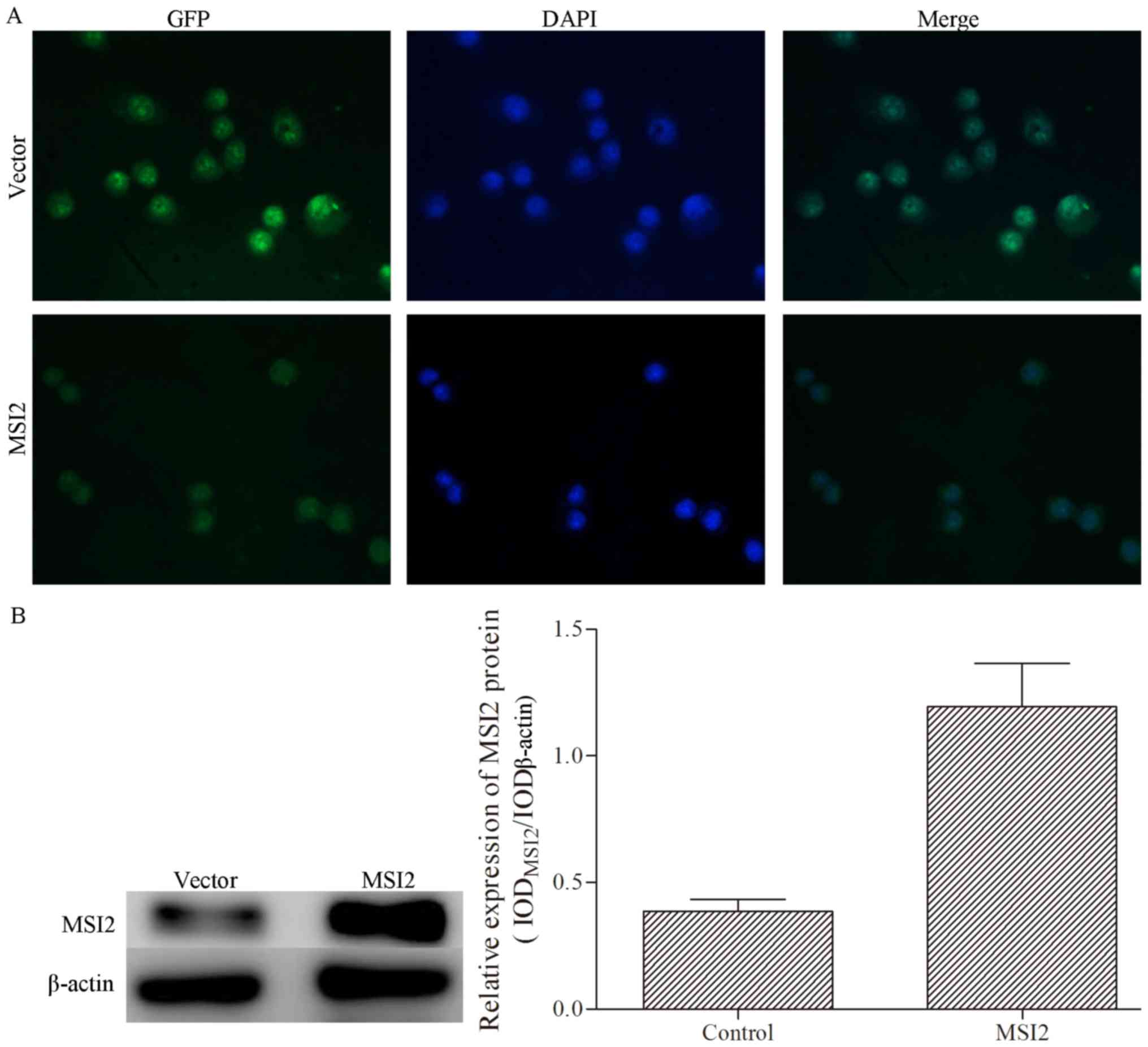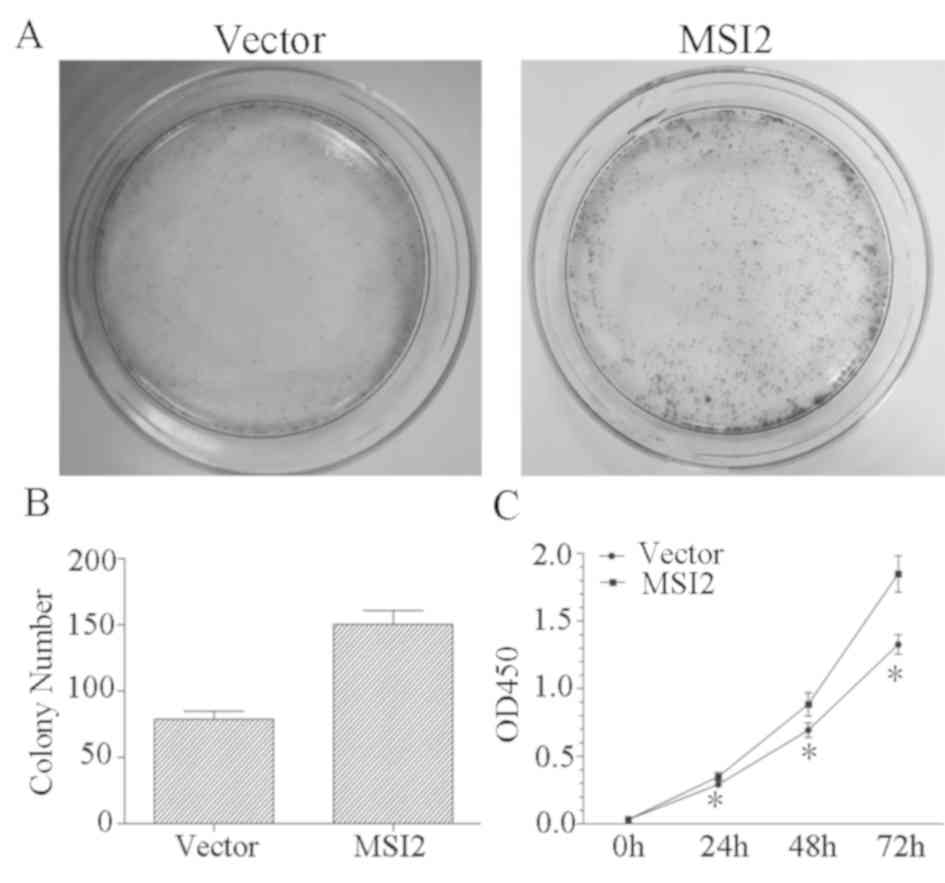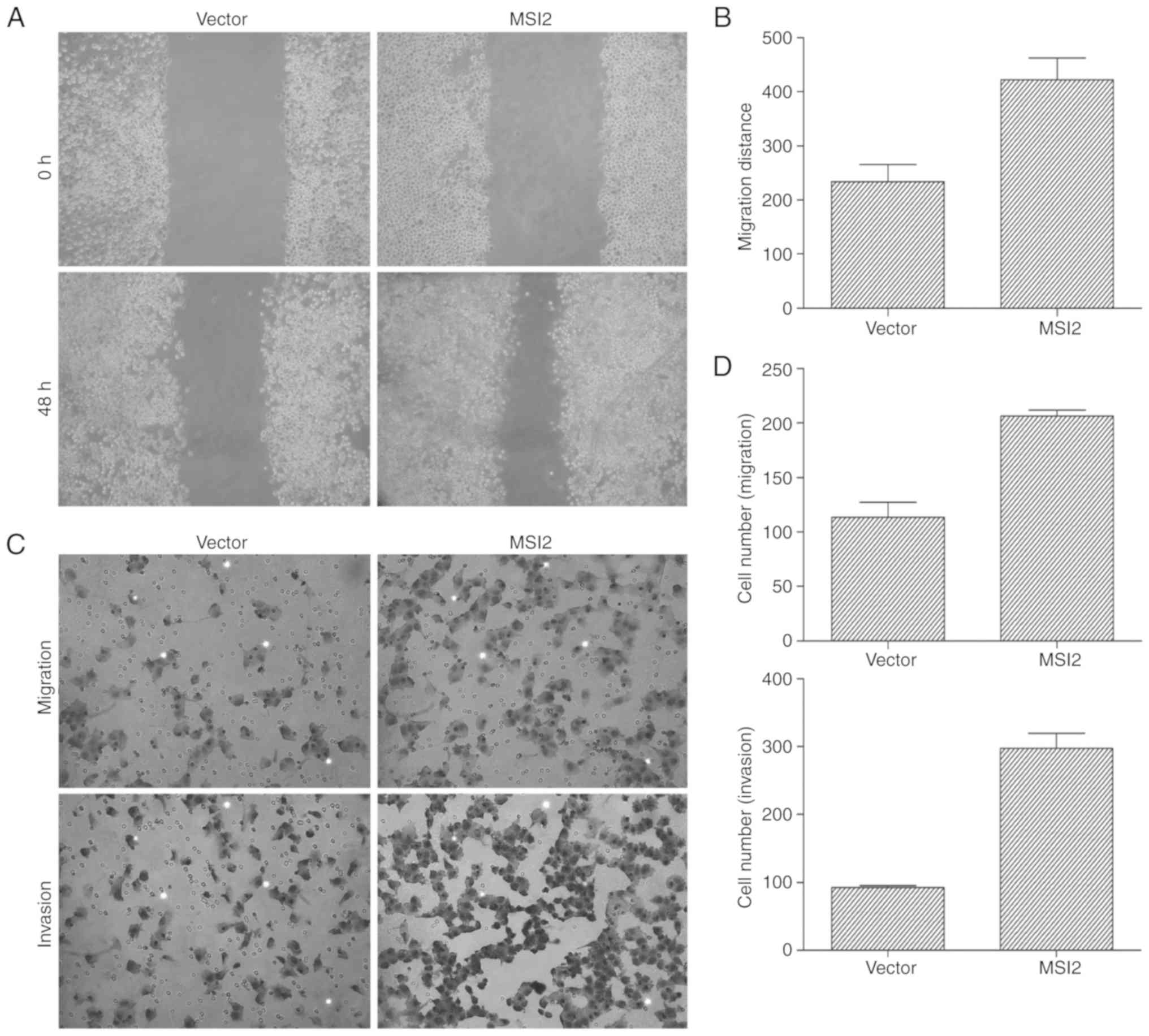Increased musashi 2 expression indicates a poor prognosis and promotes malignant phenotypes in gastric cancer
- Authors:
- Published online on: January 4, 2019 https://doi.org/10.3892/ol.2019.9889
- Pages: 2599-2606
-
Copyright: © Yang et al. This is an open access article distributed under the terms of Creative Commons Attribution License.
Abstract
Introduction
Gastric cancer (GC) is one of the most common malignancies globally (1). Despite a general decline in morbidity, GC is still one of the leading causes of cancer-associated mortality in males from less well-developed countries (2,3). Surgery is the primary form of treatment for this disease, and adjuvant chemotherapy has made significant progress in recent years (4). However, the prognosis of patients with GC who are diagnosed at advanced stage remains poor (5). Therefore, it is necessary to develop more effective therapeutic strategies in order to decrease the mortality rate of GC. Tumorigenesis and progression of GC are known to be multistep processes involving the alteration of oncogenes and tumor suppressor genes (6,7). GC-associated genes that regulate the malignant phenotype are potential therapeutic targets for GC treatment (8); therefore, it is necessary to screen for genes that are specific and sensitive.
The RNA-binding protein musashi (MSI) family are markers of stem cells and progenitor cells, which inhibit the translation of certain mRNAs and maintain the stem-cell state, also affecting cell differentiation and tumorigenesis (9,10). The family contains two paralogues, MSI1 and MSI2. These genes are also expressed in cancer cells and are associated with cell differentiation and the regulation of epithelial-to-mesenchymal transition (EMT) via inhibition of Jagged1 (11). MSI2 is predominantly expressed in hematopoietic stem cells (HSCs), where it modulates engraftment and the depletion of HSCs, and is overexpressed in myeloid leukemia, where it regulates cell proliferation ad apoptosis and indicates a poor prognosis (12). MSI2 has also been demonstrated to be involved in certain solid carcinomas. For example, MSI2 is upregulated in hepatocellular carcinoma (HCC) (13) and colorectal adenocarcinomas (14), and its upregulation promotes cell growth and invasion, and is associated with a poor prognosis. In a previous study, MSI2 was demonstrated to be downregulated in grade II GC (15). Our group inferred that a larger sample size may lead to a clearer conclusion regarding the function of MSI2 in GC.
In the present study, our group investigated the associations between MSI2 expression levels and clinicopathological characteristics of patients with GC, and its biological functions. Differences in MSI2 expression were examined in 67 pairs of GC tissues and non-cancerous tissues. Reverse transcription-quantitative polymerase chain reaction (RT-qPCR) analysis revealed that MSI2 mRNA was overexpressed in the majority of GC tissues, although no significance was observed. The aforementioned results were confirmed by western blot analysis of 8 pairs of tissues. The associations with clinicopathological factors were then examined, and the results revealed that the expression level of MSI2 mRNA was positively associated with invasion depth, tumor-node-metastasis (TNM) stage (16), degree of differentiation and tumor size. The expression levels of MSI2 were then examined in the GC cell line MKN-28, and gain-of-function assays were performed. The results indicated that MSI2 promoted MKN-28 cell proliferation, migration, invasion and neovascularization in vitro.
Materials and methods
Cell lines
Human umbilical vein endothelial cells (HUVECs) and the gastric MKN-28 cell line was originally purchased from National Infrastructure of Cell Line Resource of China (Beijing, China). This cell line was determined to be derived from MKN-74 cells (http://cellbank.nibiohn.go.jp/~cellbank/en/search_res_det.cgi?ID=340), and the authors have checked for contamination as described previously (17). Cells were cultured in Hyclone™ RPMI-1640 medium (Hyclone; GE Healthcare Life Sciences, Logan, UT, USA) with 10% Hyclone fetal bovine serum (FBS; Hyclone; GE Healthcare Life Sciences) at 37°C with 5% CO2.
Clinical samples and data collection
Of the available sample from patients with GC, a number had been used for previous study and the amount of tissue remaining was insufficient for the present study A total of 67 patients with GC with sufficient tissue for mRNA and protein extraction were selected for the present study treated at the Department of Gastrointestinal Surgery, Shandong Provincial Hospital Affiliated to Shandong University (Jinan, China) from January 2012 to December 2012. None patients had undergone treatments prior to surgery. GC tissue samples and adjacent non-cancerous tissue samples 5 cm from tumor margin were obtained from the aforementioned patients. And the tissues were stored at −80°C. The present study was approved by the Research Ethics Committee of Shandong Provincial Hospital Affiliated to Shandong University and all patients provided written informed consent.
RT-qPCR
Total RNA was extracted from GC tissue samples and adjacent non-cancerous tissue samples using RNAiso Plus reagent (cat. no. 9108/9109; Takara Bio, Inc., Otsu, Japan) according to the manufacturer's protocol. The RNA was reverse transcribed in a 20 µl reaction volume using the PrimeScript™ RT reagent kit (cat. no. RR047A; Takara Bio, Inc.) according to the manufacturer's protocol, with 2.0 µl 5X gDNA Eraser Buffer, 1.0 µl gDNA Eraser, 1.0 µg total RNA and an equal amount of RNase Free dH2O, incubated at room temperature for 5 min, and 4.0 µl 5X PrimeScript Buffer 2, 1.0 µl PrimeScript RT Enzyme Mix I, 1.0 µl RT Primer Mix*4, 4.0 µl RNase Free dH2O and 10.0 µl RNA template incubated at 37°C for 15 min followed by 85°C for 5 sec and 4°C for 30 min. qPCR analyses were performed with SYBR Premix Ex Taq™ II (Takara Bio, Inc.) using GAPDH as a reference gene. The PCR conditions were as following: denatured at 95°C for 30 sec, followed by amplification at 95°C for 5 sec and 60°C for 30 sec for 40 cycles. RT-qPCR of MSI2 mRNA expression was performed using the LightCycler 480 Real-Time PCR system (Roche Diagnostics, Basel, Switzerland), with each sample triplicated. ∆∆Cq was used to quantify the expression levels of MSI2 mRNA (18). The primer sequences used were as follows: MSI2 forward, 5′-GCAACGGCCTTTACAAATGGATAC-3′ and reverse, 5′-CAGGTCTGAGGACATCACCTAAACA-3′; GAPDH forward, 5′-GCACCGTCAAGGCTGAGAAC-3′ and reverse, 5′-TGGTGAAGACGCCAGTGGA-3′.
Western blotting
Total protein from GC and adjacent non-cancerous tissue samples was extracted with RIPA Lysis Buffer (Beyotime Institute of Biotechnology, Shanghai, China) for 30 min at 4°C, with supernatant collected following 12,000 × g centrifugation. The extracted protein was quantified with a Bicinchoninic Acid Protein Assay kit (Beyotime Institute of Biotechnology). Protein samples (~40 µg) were added to each lane, separated using 10% SDS-PAGE, and transferred to polyvinylidene fluoride (PVDF) membranes (GE Healthcare, Chicago, IL, USA). The PVDF membranes were blocked with 5% skimmed milk powder for 1 h at room temperature and washed three times with tris-buffered saline with Tween-20 (TBST), incubated with specific monoclonal primary antibodies against MSI2 (cat. no. ab76148; 1:1,000; Abcam, Cambridge, UK) at 4°C overnight, and then incubated with peroxidase-conjugated affinipure goat anti-rabbit immunoglobulin G antibodies (cat. no. ZB-2301; 1:5,000; OriGene Technologies, Inc., Beijing, China) for 1 h at room temperature and washed with TBST three times. Protein levels were normalized to total β-actin with mouse monoclonal antibody (cat. no. ab8226; 1:1,000; Abcam). The protein expression level was detected by ImageQuant LAS 4000 mini Biomolecular Imager (GE Healthcare Life Sciences) with Immobilon™ Western Chemiluminescent HRP Substrate (EMD Millipore, Billerica, MA, USA). Image J (Version 2; National Institutes of Health, Bethesda, MD, USA) was used for the quantification of grey level of bands.
Transfection of MSI2 into MKN-28 cells
The MSI2 overexpression vector pEGFP-N1-MSI2 was constructed by Shanghai Harmonious One Biotechnology Co., Ltd. (Shanghai, China). A total of 4×105 cells were seeded in 6-well cell culture plates ~24 h prior to transfection. For transfection, 10 µl Lipofectamine 2000 Reagent (Thermo Fisher Scientific, Inc.) and 4 µg plasmid vectors were prepared and mixed with Opti-MEM medium (Thermo Fisher Scientific, Inc.) according to the manufacturer's protocol, and added to 6-well culture plates with a total of 2 ml medium. Cells transfected with pEGFP-N1 (Shanghai Qihe Biotechnology Co., Ltd., Shanghai, China) were used as the control. Following 6 h transfection, the medium was replaced and the fluorescence activity of green fluorescent protein was used to measure transfection efficiency 24 h after transfection, and the nuclei were stained with DAPI. The images were captured using an inverted fluorescence microscope (Nikon Ti-S; Nikon Corporation, Tokyo, Japan). MSI2 protein expression levels were measured by western blotting, as aforementioned.
Cell proliferation assays
Colony formation assays were performed to evaluate cell proliferation. Cells transfected with the aforementioned vectors were trypsinized into single cell suspensions, and 1×103 cells were seeded in 35 cm2 culture plates with 2 ml RPMI-1640 medium with 10% FBS. The cells were stained with hematoxylin for 10 min at 37°C following culture at 37°C with 5% CO2 for 2 weeks.
A Cell Counting Kit-8 (CCK-8) assay was also performed to assess GC cell proliferation. A total of 2.5×103 MKN-28 cells, transfected as aforementioned, were seeded in 96-well plates and cultured with 100 µl RPMI-1640 medium with 10% FBS at 37°C with 5% CO2. After 24, 48 and 72 h culture, 10 µl CCK-8 (Dojindo Molecular Technologies, Inc., Kumamoto, Japan) was added to each plate and cultured at 37°C with 5% CO2 for 1 h. The optical density (OD) at 450 nm was measured to assess cell proliferation, and each group was replicated five times in total.
Invasion and migration assays
Transwell assays were performed to measure the invasion and migration MKN-28 cell, transfected as aforementioned. For the invasion assay, 50 µl diluted Matrigel (BD Biosciences, San Jose, CA, USA) was added in the upper chamber of Transwell plates (24-well plate inserts, 8 µm pore size; Corning Incorporated, Corning, NY, USA). Then, 6×105 cells were seeded in 200 µl RPMI-1640 medium with 0.5% bovine serum albumin (Sigma-Aldrich; Merck KGaA, Darmstadt, Germany), and 500 µl RPMI-1640 medium with 10% FBS was added to each lower chamber. For the migration assays, no Matrigel was added to the upper chamber and 8×104 cells were seeded. All of the 24-well culture plates used for the invasion and migration assays were incubated at 37°C with 5% CO2 for 24 h. Finally, after wiping off the non-migrated or non-invaded cells in the upper chamber with a cotton swab, the membranes were separated and stained with hematoxylin. The cells that had penetrated to the lower chamber were counted and photographed using a light microscope (Leica DM4000B; Leica Microsystems GmbH, Wetzlar Germany), and mean level of three fields was used for evaluation.
Wound healing assays were also performed to confirm the migratory function of transfected MKN-28 cells. GC cells were seeded into 6-well plates with 2 ml RPMI-1640 medium with 10% FBS and permitted to grow to 90% confluence. Then, a wound field was made using a sterile 200 µl pipette tip. Separated cells were detached with 2 ml RPMI-1640 medium without FBS. The cells were then incubated at 37°C with 5% CO2. Pictures were captured using a digital camera system at 2 time points (0 and 48 h) and migration distance was used to evaluate migration activity.
Tube formation assay in HUVECs
GC cells, transfected as aforementioned, were plated in 6-well culture plates with 2 ml RPMI-1640 medium with 10% FBS. When cells reached ~90% confluence, they were washed twice with PBS buffer and the medium was changed to 2 ml RPMI-1640 medium with 10% FBS. After 24 h culture in an incubator at 37°C with 5% CO2, the conditional media were collected. A total of 100 µl growth-factor reduced Matrigel (BD Biosciences) was used to coat a 96-well plate, and HUVECs (5×103) were seeded and cultured at 37°C with 5% CO2. HUVECs cultured in the conditional media were observed using a light microscope (Leica Microsystems GmbH) after 6–8 h culture. Numbers of tubes were used to evaluate the tube formation ability. And tubes in three fields were counted.
Statistical analysis
Statistical analysis was performed using SPSS 18.0 software (SPSS, Inc., Chicago, IL, USA). The OD values are expressed as the mean ± standard deviation of at least three separate experiments, and the OD450 values are expressed as the mean ± standard deviation of at least five separate experiments. The χ2 test was used to calculate the associations between clinicopathological characteristics, and the independent samples Student's t test was used to analyze the differences between MSI2 overexpression groups and vector groups. Overall survival was assessed using the Kaplan-Meier method with log rank test. P<0.05 was considered to indicate a statistically significant difference.
Results
MSI2 is upregulated in GC tissues and is associated with clinicopathological features of patients with GC
Although a previous investigation of 30 pairs of GC tissues and paired normal tissues revealed that MSI2 mRNA expression levels were not significantly different (15), analysis of a larger number of samples in the present study revealed that MSI2 mRNA expression levels were increased in the majority of GC tissues compared with adjacent normal controls, although there was no significant difference (Fig. 1A). MSI2 protein expression was also upregulated in 8 pairs of tissues (Fig. 1B). Next, two folds of MSI2 mRNA expression, compared with adjacent non-cancerous tissues was set as the cut-off value, and the associations between MSI2 mRNAs levels and clinicopathological features of patients with GC were investigated in 67 pairs of tissues. The results revealed that MSI2 mRNA overexpression was associated with invasion depth, TNM stage, degree of differentiation and tumor sizes (P<0.05; Table I). However, no associations were observed between MSI2 mRNA expression levels and other clinicopathological characteristics including sex, age, tumor location and human epidermal growth factor receptor 2 expression.
Table I.Associations between MSI2 mRNA expression and clinicopathological features of patients with gastric cancer. |
Upregulation of MSI2 is associated with poor prognosis in GC
The overall survival of patients with GC following surgery was analyzed using the Kaplan-Meier method. The patients were classified into two groups according to the relative expression of MSI2 (MSI2 mRNA/GAPDH mRNA): A low expression group with 25 patients (group 1; cancer/normal <2) and a high expression group with 42 patients (group 2; cancer/normal ≥2). The overall survival rate was significantly lower in group 1 (Fig. 2; χ2=4.221, P=0.040), indicating that MSI2 expression is associated with a poor prognosis in GC.
MSI2 promotes GC cell proliferation, migration and invasion
MKN-28 cells were transfected with pEGFP-N1 with a reporter gene encoding green fluorescence protein, and the transfection efficiency was verified by inverted fluorescence microscopy and western blotting (Fig. 3). MSI2 expression was successfully induced in MKN-28 cells by pEGFP-N1-MSI2, and an empty vector was used as the negative control. The results of the colony formation assay revealed that colony numbers were significantly increased in the MSI2 group compared with the control group (Fig. 4A and B), and the results of the CCK-8 assay revealed that MKN-28 cells overexpressing MSI2 proliferate faster than MKN-28 cells transfected with the empty vector (Fig. 4C). To assess the effects of MSI2 on GC cell migration and invasion, Transwell assays and wound healing assays were performed in MKN-28 cells following transfection with MSI2 expression vectors and the corresponding empty vector control. The results of the wound healing assay demonstrated that cells in the MSI2-overexpression group migrated further than those in the empty vector control group (Fig. 5A and B), and the Transwell assay results for invasion and migration revealed that the number of cells in the lower chambers were significantly increased in the MSI2-overexpression group compared with the control group (Fig. 5C and D). Taken together, these results indicated that MSI2 promotes GC cell proliferation, migration and invasion.
MSI2 promotes tube formation in vivo
To assess the effects of MSI2 on tube formation in HUVECs, a Matrigel tube formation test was performed. The results revealed that the tubular formation activity of MSI2-overexpression MKN-28 cells was significantly increased compared with the empty vector control (Fig. 6). These results indicated that MSI2 promotes tubular formation in HUVECs in vitro.
Discussion
GC remains a substantial threat to human health (2,3). Although the overall survival of patients with GC has increased (19), outcomes in China remain worse than that in the USA at present (20). Although developments in endoscopic screening and biopsies have improved screening strategies for early stage GC, and laparoscopic resection has increased the ratio of early stage patients that receive treatment (21), endoscopic screening is impractical in general clinical practice due to its invasive nature. Furthermore, the biological mechanisms underlying GC still remain to be comprehensively elucidated, although GC tumorigenesis and development are known to be long, multistep processes involving various genetic alterations, including oncogenic activation and the inactivation of tumor suppressor pathways (22). However, since the biological mechanisms GC remain unclear, prolonging the overall survival of patients with GC by improving treatment strategies will be difficult. Therefore, the discovery of novel biomarkers, regulatory molecules and therapeutic targets for GC will help to improve the prognosis of GC and overall public health.
MSI2 is a member of the MSI family, which is involved in the maintenance of stem cells and the regulation of cell differentiation (9,10). MSI2 is involved in the development of the central nervous system, and binds to the poly A-binding protein to regulate gene expression at the post-transcriptional level (23). Previously, MSI2 was indicated to be involved in GC; however, no alteration of MSI2 expression levels were observed and decreased expression levels in grade II GC were observed (15). However, the use of MSI2 as a biomarker for GC and its involvement in the regulation of GC remain to be fully elucidated.
MSI2 has been demonstrated to be involved in malignancies of the circulatory system and to promote a malignant phenotype (12,24,25), and has also been indicated to be dysregulated in several types of solid cancer, and to promote the malignant activity of these cancer cells. MSI2 has been demonstrated to be associated with tumor size, tumor differentiation, the number of tumor nodules, Barcelona clinic liver cancer stage, vascular invasion, recurrence and poor prognosis in HCC (13,26). In the present study, the expression levels of MSI2 mRNA and protein in GC tissues and adjacent non-cancerous tissues were assessed using by RT-qPCR and western blotting, respectively. The results suggested that MSI2 was upregulated in the majority of GC tissues compared with adjacent non-cancerous tissues, although there was no significant difference. To classify the clinical value of MSI2, the associations between MSI2 and the clinicopathological features of patients with GC were than analyzed. The results revealed that MSI2 expression levels were associated with malignant GC phenotypes, including invasion depth, TNM stage, degree of differentiation and tumor size. Furthermore, overexpression of MSI2 resulted in a poorer prognosis in patients with GC. Taken together, the aforementioned results indicate that MSI2 is a potential valuable biomarker for the diagnosis of GC and for determining GC prognosis, as it has oncogenic functions.
The differences between cancer cells and normal cells include sustained proliferation, the evasion of growth suppression, resistance to cell death, replicative immortality, angiogenesis, invasion and metastasis (27). MSI2 has been demonstrated to promote HCC invasion and progression by activating EMT or via the Wnt/β-catenin signaling pathway (13,26). To investigate the biological functions of MSI2 in GC cells, MSI2 expression was induced by transfection of an expression vector into the GC cell line MKN-28, and gain-of-function assays were performed in vitro. CCK-8 and colony formation assays were performed to elucidate the function of MSI2 in GC cell proliferation. The results revealed that MSI2 overexpression resulted in increased proliferation in the MKN-28 cell line and an increased number of colonies, indicating that MSI2 promoted MKN-28 cell proliferation. Wound healing assays and Transwell migration and invasion assays were performed to investigate the involvement of MSI2 in GC cell migration and invasion. An increased number of cells recorded in the lower chambers and a decreased width of the scratch compared with the control group indicated that MSI2 promoted GC cell migration and invasion. The aforementioned results indicated MSI2 may serve oncogenic functions in GC by directly invading the extracellular matrix, which is the natural protective barrier, and migrating to adjacent organs. To explore whether MSI2 promoted GC metastasis in other ways, tubular formation assays were performed in HUVECs. The results revealed that more tubes were formed in the MSI2 overexpression group compared with the control group. This indicated that MSI2 promoted vessel formation activity in HUVECs, suggesting that MSI2 promotes angiogenesis. Taken together, these results indicate that MSI2 acts as an oncogene and is involved in the promotion of GC carcinogenesis and progression.
In conclusion, MSI2 mRNA and protein expression levels were increased in GC tissues, so it may be a potential biomarker for GC diagnosis following verification from a larger sample. Furthermore, MSI2 expression is associated with various malignant phenotypes, including invasion depth, TNM stage, degree of differentiation and tumor size, and is a risk factor for determining the prognosis of GC. The in vitro assays demonstrated that MSI2 promotes GC cell proliferation, migration, invasion and angiogenesis. These results indicated that MSI2 may act as an oncogene in GC by increasing proliferation and promoting metastasis via inducing migration, invasion and angiogenesis. However, the underlying mechanisms and signaling pathways remain unclear, and further investigations with a large scale of samples and GC cell lines are required to assess the potential clinical applications of MSI2.
Acknowledgements
Not applicable.
Funding
The present study was supported by grants from the National Natural Science Foundation of China (grant nos. 81672379 and 81572355), the Natural Science Foundation of Shandong Province (grant nos. ZR2015HM078 and ZR2016HM16) and the Taishan Young Scholars Foundation of Shandong Province (grant no. TSQN20161072). The processes of study design, data collection, analysis and interpretation and manuscript writing had no funding body participation.
Availability of data and materials
The datasets used and/or analyzed during the current study are available from the corresponding author on reasonable request.
Authors' contributions
XG designed the experiment, provided financial support, revised the manuscript and gave final approval of the version to be published. XG was responsible for the interpretation of data. ZY and JL performed the experiments, acquired the data and wrote the paper. YS and LL made substantive contibutions to the work, including data collecting and manuscript revising..
Ethics approval and consent to participate
The present study was approved by the Research Ethics Committee of Shandong Provincial Hospital Affiliated to Shandong University (approval no. 2012-101) and all patients provided written informed consent to participate.
Patient consent for publication
The patients' data was anonimised, and hospital numbers and associated data may be provided only for scientific purposes. All patients provided written informed consent that their data may be published.
Competing interests
The authors declare that they have no competing interests.
References
|
Ferlay J, Soerjomataram I, Dikshit R, Eser S, Mathers C, Rebelo M, Parkin DM, Forman D and Bray F: Cancer incidence and mortality worldwide: Sources, methods and major patterns in GLOBOCAN 2012. Int J Cancer. 136:E359–E386. 2015. View Article : Google Scholar : PubMed/NCBI | |
|
Bertuccio P, Chatenoud L, Levi F, Praud D, Ferlay J, Negri E, Malvezzi M and La Vecchia C: Recent patterns in gastric cancer: A global overview. Int J Cancer. 125:666–673. 2009. View Article : Google Scholar : PubMed/NCBI | |
|
Torre LA, Bray F, Siegel RL, Ferlay J, Lortet-Tieulent J and Jemal A: Global cancer statistics, 2012. CA Cancer J Clin. 65:87–108. 2015. View Article : Google Scholar : PubMed/NCBI | |
|
Lordick F and Terashima M: Gastric cancer adjuvant therapy. Best Pract Res Clin Gastroenterol. 30:581–591. 2016. View Article : Google Scholar : PubMed/NCBI | |
|
Catalano V, Labianca R, Beretta GD, Gatta G, de Braud F and Van Cutsem E: Gastric cancer. Crit Rev Oncol Hematol. 54:209–241. 2009. View Article : Google Scholar | |
|
Sugimura T, Terada M, Yokota J, Hirohashi S and Wakabayashi K: Multiple genetic alterations in human carcinogenesis. Environ Health Perspect. 98:5–12. 1992. View Article : Google Scholar : PubMed/NCBI | |
|
Guo X, Liu W, Pan Y, Ni P, Ji J, Guo L, Zhang J, Wu J, Jiang J, Chen X, et al: Homeobox gene IRX1 is a tumor suppressor gene in gastric carcinoma. Oncogene. 29:3908–3920. 2010. View Article : Google Scholar : PubMed/NCBI | |
|
Wang Z, Tang F, Qi G, Yuan S, Zhang G, Tang B and He S: KDM5B is overexpressed in gastric cancer and is required for gastric cancer cell proliferation and metastasis. Am J Cancer Res. 5:87–100. 2014.PubMed/NCBI | |
|
Okano H, Imai T and Okabe M: Musashi: A translational regulator of cell fate. J Cell Sci. 115:1355–1359. 2002.PubMed/NCBI | |
|
Siddall NA, McLaughlin EA, Marriner NL and Hime GR: The RNA-binding protein Musashi is required intrinsically to maintain stem cell identity. Proc Natl Acad Sci USA. 103:8402–8407. 2006. View Article : Google Scholar : PubMed/NCBI | |
|
Katz Y, Li F, Lambert NJ, Sokol ES, Tam WL, Cheng AW, Airoldi EM, Lengner CJ, Gupta PB, Yu Z, et al: Musashi proteins are post-transcriptional regulators of the epithelial-luminal cell state. Elife. 3:e039152014. View Article : Google Scholar : PubMed/NCBI | |
|
Kharas MG, Lengner CJ, Al-Shahrour F, Bullinger L, Ball B, Zaidi S, Morgan K, Tam W, Paktinat M, Okabe R, et al: Musashi-2 regulates normal hematopoiesis and promotes aggressive myeloid leukemia. Nat Med. 16:903–908. 2010. View Article : Google Scholar : PubMed/NCBI | |
|
He L, Zhou X, Qu C, Hu L, Tang Y, Zhang Q, Liang M and Hong J: Musashi2 predicts poor prognosis and invasion in hepatocellular carcinoma by driving epithelial-mesenchymal transition. J Cell Mol Med. 18:49–58. 2014. View Article : Google Scholar : PubMed/NCBI | |
|
Wang S, Li N, Yousefi M, Nakauka-Ddamba A, Li F, Parada K, Rao S, Minuesa G, Katz Y, Gregory BD, et al: Transformation of the intestinal epithelium by the MSI2 RNA-binding protein. Nat Commun. 6:65172015. View Article : Google Scholar : PubMed/NCBI | |
|
Emadi-Baygi M, Nikpour P, Mohammad-Hashem F, Maracy MR and Haghjooy-Javanmard S: MSI2 expression is decreased in grade II of gastric carcinoma. Pathol Res Pract. 209:689–691. 2013. View Article : Google Scholar : PubMed/NCBI | |
|
Sobin LH, Gospodarowicz MK and Wittekind C: TNM classification of Malignant Tumours. (7th). Wiley-Blackwell. Hoboken, NJ. 2009. | |
|
Capes-Davis A, Theodosopoulos G, Atkin I, Drexler HG, Kohara A, MacLeod RA, Masters JR, Nakamura Y, Reid YA, Reddel RR and Freshney RI: Check your cultures! A list of cross-contaminated or misidentified cell lines. Int J Cancer. 127:1–8. 2010. View Article : Google Scholar : PubMed/NCBI | |
|
Livak KJ and Schmittgen TD: Analysis of relative gene expression data using real-time quantitative PCR and the 2(-Delta Delta C(T)) method. Methods. 25:402–8. 2001. View Article : Google Scholar : PubMed/NCBI | |
|
Zheng L, Wu C, Xi P, Zhu M, Zhang L, Chen S, Li X, Gu J and Zheng Y: The survival and the long-term trends of patients with gastric cancer in Shanghai, China. BMC Cancer. 14:3002014. View Article : Google Scholar : PubMed/NCBI | |
|
Strong VE, Wu AW, Selby LV, Gonen M, Hsu M, Song KY, Park CH, Coit DG, Ji JF and Brennan MF: Differences in gastric cancer survival between the U.S. and China. J Surg Oncol. 112:31–37. 2015. View Article : Google Scholar : PubMed/NCBI | |
|
Leja M, You W, Camargo MC and Saito H: Implementation of gastric cancer screening-the global experience. Best Pract Res Clin Gastroenterol. 28:1093–1106. 2014. View Article : Google Scholar : PubMed/NCBI | |
|
Figueiredo C, Costa S, Karameris A and Machado JC: Pathogenesis of gastric cancer. Helicobacter. 20 Suppl 1:S30–S35. 2015. View Article : Google Scholar | |
|
Sakakibara S, Nakamura Y, Satoh H and Okano H: Rna-binding protein Musashi2: Developmentally regulated expression in neural precursor cells and subpopulations of neurons in mammalian CNS. J Neurosci. 21:8091–1107. 2001. View Article : Google Scholar : PubMed/NCBI | |
|
Mansouri L, Gunnarsson R, Sutton LA, Ameur A, Hooper SD, Mayrhofer M, Juliusson G, Isaksson A, Gyllensten U and Rosenquist R: Next generation RNA-sequencing in prognostic subsets of chronic lymphocytic leukemia. Am J Hematol. 87:737–740. 2012. View Article : Google Scholar : PubMed/NCBI | |
|
Thol F, Winschel C, Sonntag AK, Damm F, Wagner K, Chaturvedi A, Göhring G, Schlegelberger B, Lubbert M, Fiedler W, et al: Prognostic significance of expression levels of stem cell regulators MSI2 and NUMB in acute myeloid leukemia. Ann Hematol. 92:315–323. 2013. View Article : Google Scholar : PubMed/NCBI | |
|
Wang MH, Qin SY, Zhang SG, Li GX, Yu ZH, Wang K, Wang B, Teng MJ and Peng ZH: Musashi-2 promotes hepatitis Bvirus related hepatocellular carcinoma progression via the Wnt/β-catenin pathway. Am J Cancer Res. 5:1089–1100. 2015.PubMed/NCBI | |
|
Hanahan D and Weinberg RA: Hallmarks of cancer: The next generation. Cell. 144:646–674. 2011. View Article : Google Scholar : PubMed/NCBI |



